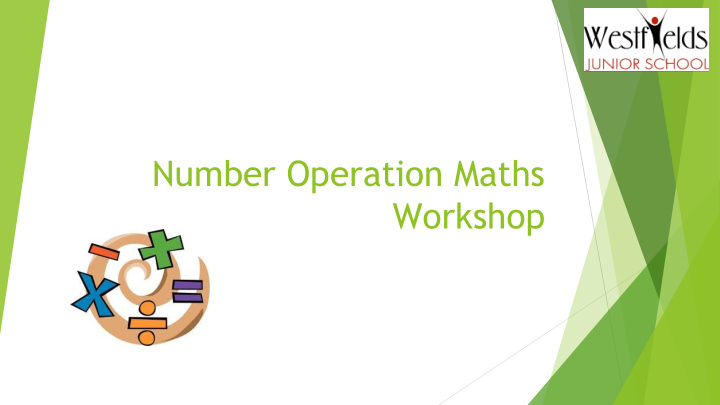



Number Operation Maths Workshop
Warming up our brains for Maths What is you favourite ice cream?
Mathematical Fluency: A recap on the last parent workshop
The three aspects of fluency with number Efficiency - this implies that children do not get bogged down in too many steps or lose track of the logic of the strategy. An efficient strategy is one that the student can carry out easily, keeping track of sub-problems and making use of intermediate results to solve the problem. Accuracy depends on several aspects of the problem-solving process, among them careful recording, knowledge of number facts and other important number relationships, and double-checking results. Flexibility requires the knowledge of more than one approach to solving a particular kind of problem, such as two-digit multiplication. Pupils need to be flexible in order to choose an appropriate strategy for the numbers involved, and also be able to use one method to solve a problem and another method to check the results. So fluency demands more of pupils than memorising a single procedure – they need to understand why they are doing what they are doing and know when it is appropriate to use different methods.
The Smith family Why might the Smiths find it difficult to support their children with their Maths home learning?
Addition and subtraction: Do I borrow or do I carry?
What does the National Curriculum say about addition and subtraction? Year 3 - Add and subtract numbers with up to three digits, using formal written methods of columnar addition and subtraction. Year 4 - Add and subtract numbers with up to 4 digits using the formal written methods of columnar addition and subtraction where appropriate. Year 5 - Add and subtract whole numbers with more than 4 digits, including using formal written methods (columnar addition and subtraction) and solve addition and subtraction multi-step problems in contexts, deciding which operations and methods to use and why Year 6 - Solve addition and subtraction multi-step problems in contexts, deciding which operations and methods to use and why
Click on this link to watch a video Top Tip! BBC Bitesize have amazing videos that explain things simply and in an engaging way!
Addition – using a number line Your turn: 27 + 56 124 + 233
Addition – partitioning and expanded column methods Your turn: 57 + 29 368 + 176
Addition – formal method Your turn: 726 + 436 537 + 618
Mastering the four number operations: Now we know it, what do we do with it?
Click on this link to watch a video Top Tip! BBC Bitesize have amazing videos that explain things simply and in an engaging way!
Subtraction – numberline method Your turn: 85 - 36 193 - 27
Subtraction – numberline method Your turn: 736 - 272 638 - 389
Subtraction – formal column method Your turn: 924 - 476 3,363 - 1,539
Mastering the four number operations: Now we know it, what do we do with it?
Multiplication and Division: Something about arrays and bus stops?
What does the National Curriculum say about multiplication and division? Year 3 Write and calculate mathematical statements for multiplication and division using the multiplication tables that they know, including for two-digit numbers times one-digit numbers, using mental and progressing to formal written methods Year 4 Multiply two-digit and three-digit numbers by a one-digit number using formal written layout Year 5 Multiply numbers up to 4 digits by a one- or two-digit number using a formal written method, including long multiplication for two-digit numbers Divide numbers up to 4 digits by a one-digit number using the formal written method of short division and interpret remainders appropriately for the context Year 6 multiply multi-digit numbers up to 4 digits by a two-digit whole number using the formal written method of long multiplication divide numbers up to 4 digits by a two-digit whole number using the formal written method of long and short division, and interpret remainders as whole number remainders, fractions, or by rounding, as appropriate for the context
Embed this video https://www.youtube.com/watch?v=0b9Tta4jeVI Top Tip! BBC Bitesize have amazing videos that explain things simply and in an engaging way!
Multiplication – arrays and number lines
Multiplication – grid method Your turn: 127 x 4 25 x 37
Multiplication – expanded and column multiplication Your turn: 132 x 6 414 x 5
Mastering the four number operations: Now we know it, what do we do with it?
Division – the tricky one!
Sharing Grouping 6 ÷ 2 6 ÷ 2 Your turn: Using the counters, what are the two ways you could show 10 ÷ 5?
Division – number line Your turn: 48 / 4 69 / 3
Division – short division Your turn: 532 / 3 641 / 5
Mastering the four number operations: Now we know it, what do we do with it?
What’s next? Calculation Policy on the school website • Try the games we have practised today • with your child - they’ll love it! Supporting home learning through the • methods we have explored today Visit Nrich and BBC Bitesize •
Recommend
More recommend